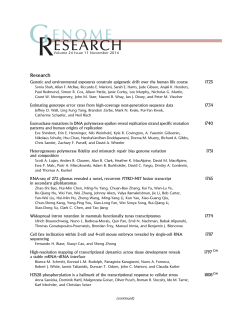
THE REPRESSILATOR
THE REPRESSILATOR A synthetic oscillatory network of transcriptional regulators Michael B. Elowitz & Stanislas Leibler, 2000 Context • The « design principles » underlying networks of interacting biomolecules are poorly understood ! Comparing designed networks with their natural counterparts may help to understand such « design principles » Goals • Design and construction of a synthetic network to implement a particular function • identify possible classes of dynamic behaviour and determine which experimental parameters should be adjusted to obtain sustained oscillations • Doing it with new functional properties from generic components that naturally occur in other contexts. General specificities • Used 3 transcriptional repressor systems, termed the repressilator, in Escherichia coli. • The network periodically induces the synthesis of green fluorescent protein • oscillations, with typical periods of hours, are slower than the cell-division cycle, so the state of the oscillator has to be transmitted from generation to generation. Cyclic negative-feedback loop • REPRESSILATOR: 3 repressors genes and their corresponding promoters • Reporter: expresses an intermediate-stability GFP variant Network Design simple mathematical model of transcriptional regulation Deterministic, continuous approximation (= continuous dynamical variables) • α0 is the number of protein copies per cell produced from a given promoter type during continuous growth in the presence of saturating amounts of repressor • α+α0 is the number of protein copies in the absence of repressor • β denote the ratio of the protein decay rate to the mRNA decay rate • n is a Hill coefficient Deterministic model: results • Depending on the values of the model’s parameters, the system may converge toward a stable steady state, or the steady state may become unstable, leading to a sustained limit-cycle oscillations. Experimental approach • used standard molecular biology techniques to construct a low-copy plasmid encoding the repressilator and a compatible, higher-copy reporter plasmid containing the tet-repressible promoter PLtetO1 fused to an intermediate stability variant of gfp11 • Because the inducer IPTG interferes with repression by LacI, we expected that a transient pulse of IPTG might be capable of synchronizing a population of repressilatorcontaining cells. Increasing the chance to get an oscillatory regime • two alterations to natural components: 1. use strong, yet tightly repressible hybrid promoters ! address transcriptional strength and tightness 2. insert a carboxy-terminal tag at the end of each repressor protein ! Proteases in E. coli recognize this tag and target the attached protein for destruction ! bring the effective repressor protein lifetimes closer to that of mRNA Experimental approach: results • Single damped oscillation of GFP fluorescence per cell after transfer to media lacking IPTG. • no global synchronization (not expected) ! studied the repressilator by isolating single cells under the microscope and monitoring their fluorescence intensity as they grew • total observation time was limited about 10 hours of growth at 30°C. ! colonies enter in a stationary phase Experimental approach: results • period of around 150 minutes, 3 times longer than the typical celldivision time. Oscillatory behavior and negative controls Red = fluorescence of reference cell Green and blue = two references siblings cells (cellules filles) • In some individuals, periods were omitted or phase delayed in one cell relative to its sibling (a,b,c) • significant variations in the period and amplitude of the oscillator (d) • (e) includes deliberate disruption of the network (by adding sufficient IPTG to interfere with LacI) and (f) observation of GFP expression in the absence of the repressilator (only the reporter) Stochastic, discrete approximation • stochastic effects may be responsible for noisy operation in natural gene-expression networks. ! adapt equations to perform stochastic simulations. !to obtain cooperativity in repression analogous to the continuous case: assumed two operator sites on each promoter and change several parameters. • In order to distinguish such stochastic effects from possible intrinsically complex dynamics (such as intermittence or chaotic behaviour), further studies are needed. Stochastic, discrete approximation • Oscillations persist with the stochastic model and adapted parameters values but with a large variability, ?resulting in a finite autocorrelation time? Conclusion • By varying the host species and genetic background would allow to reduce spurious interactions with endogenous cellular sub-systems, and to investigate how the network is embedded in the cell. ! In fact, the entry into the stationary phase stops the repressilator, indicating that the network is coupled to the global regulation of cell growth. • Instead of three repressors, it seems that circadian oscillators use both positive and negative control elements. In the presence of interactions between positive and negative control elements that lead to bistable, hysteretic behavior, an oscillating circuit shows high noise-resistance.
© Copyright 2025











